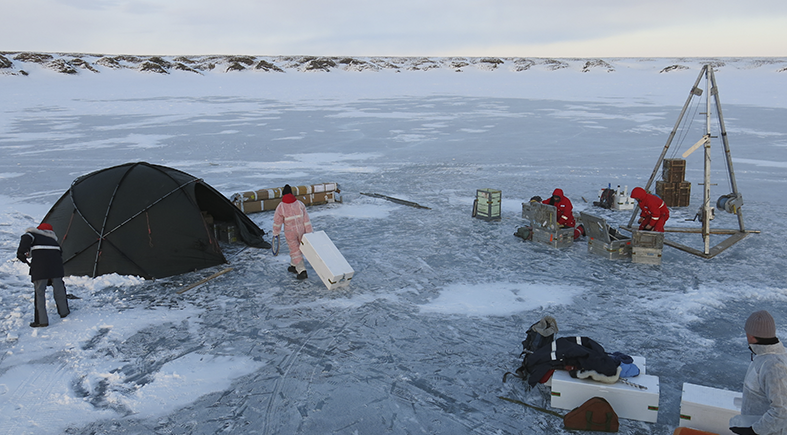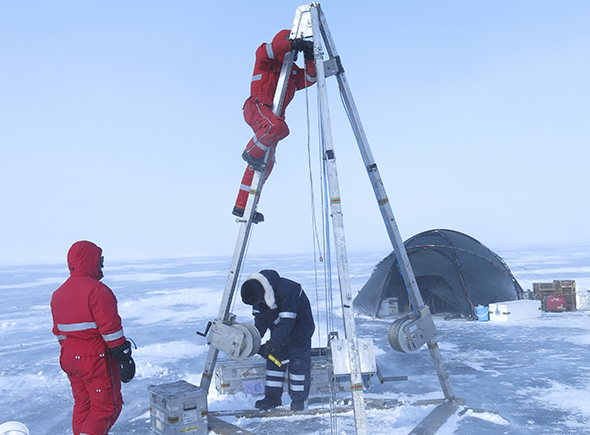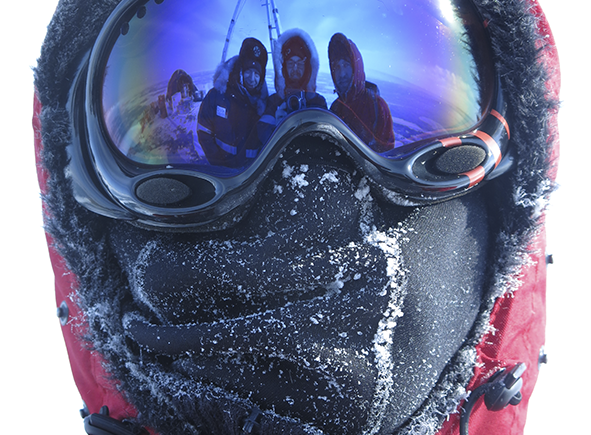27.04.2017: The permafrost landscapes in the northern hemisphere are regarded as key regions for global change and are, thus, of particular interest for research. As a result of global warming, large areas are gradually thawing and hereby large amounts of carbon dioxide and methane are released into the atmosphere. However, to date only rough estimates are available on how much greenhouse gas actually escapes.
A team of scientists from the GFZ German Research Centre for Geosciences and the Alfred Wegener Institute for Polar and Marine Research (AWI) are now hoping to obtain more detailed information from investigations conducted in the permafrost of the Lena Delta. During the past four weeks and under extremely difficult conditions the scientists together with their Russian partners have drilled into the underground on the Siberian peninsula Bykovsky. Here in the far north of Siberia, the landscape is still covered by a dense layer of snow. Temperatures fell to minus 29 degrees Celsius and strong winds often prevailed. The scientists reported that even allegedly “simple work” such as changing of the drill rod became a true torture under these conditions and took much longer than normal. They had, however, no choice: anyone who wants to explore the permafrost should preferably come in winter. In summer, when the top layer is thawing, crew and heavy equipment sink quickly into the soft terrain.
The German-Russian team was spared this fate. Work has just been successfully completed with a total of 96 meters of cores now recovered. “The samples are cooled and then taken to Potsdam for further analyzes in our laboratory,” says Prof. Susanne Liebner, Leader of the Helmholtz Young Investigators Research Group MicroCene at the Geomicrobiology Section at GFZ. “Here, we investigate the microbial life communities and their function in the carbon cycle in the different sediments.” In this way, Liebner's team aims to find out which metabolic processes occur in the different zones. “Previous studies have already shown that as a result of microbial processes part of the methane (CH4) is converted to carbon dioxide (CO2) within the transition zone between permanently frozen ground and the thawed layers” says Liebner. “Although this is also a greenhouse gas it has a much lesser effect on the climate compared to methane. This so-called microbial methane filter is an important sink in the carbon cycle.” Current research is expected to provide more precise data on the nature and quantity of greenhouse gases actually released from the thawing permafrost due to global warming.
Aside from the geomicrobiological studies of GFZ, the AWI team investigates the extent and the speed of the permafrost degradation, i.e. the changes that occur during the course of rising temperature. This information is also important for the Arctic infrastructure. Already today there are a number of problems as houses and streets which had once been erected on frozen ground are now sinking into the soft underground due to the thawing process.










![[Translate to English:] Torsten Sachs in front of a climate station on a field](/fileadmin/_processed_/3/9/csm__TorstenSachs_bearbeitet_GS_4a1365ef84.jpeg)

![[Translate to English:] left image flood at the Ahrtal: image from above, several houses are flooded; left image:: Heidi Kreibich;](/fileadmin/_processed_/4/4/csm_Bild2_9af0130e9f.png)



![[Translate to English:] Start der Vega Rakete](/fileadmin/_processed_/6/4/csm_20231201-kachel_Vega-VV23-launch_ESA-CNES-Arianespace_706716b68c.jpeg)









![[Translate to English:] Poster exhibition at the Brandenburg Hydrogen Day at the GFZ, some participants in the foreground](/fileadmin/_processed_/6/5/csm_Erster_Brandenburgischer_Wasserstofftag_GFZ_402fcec95e.jpeg)
![[Translate to English:] Group picture of the participants](/fileadmin/_processed_/9/4/csm_20231108_CAWa-Workshop-Tashkent_Gruppenbild_99ea779d8a.jpeg)

![[Translate to English:] [Translate to English:] Hörsaal](/fileadmin/_processed_/e/6/csm_H%C3%B6rsal_e21ac645fb.jpeg)


![[Translate to English:] The Delegations in the Historic Library on the Telegrafenberg. In the back there are from left to right, the Dutch Ambassador for Germany, Ronald van Roeden, the Dutch Minister for Education, Culture and Science, Robbert Dijkgraaf and the scientific director of the GFZ, Susanne Buiter.](/fileadmin/_processed_/d/b/csm_Kachel-2_9eba4b4212.jpeg)

